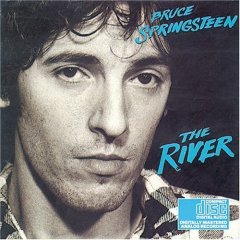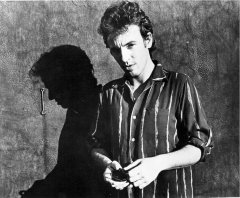Graham Reid | | 11 min read
Bruce Springsteen: Johnny Bye-Bye

For Bruce Springsteen -- born in the unpromisingly named town of Freehold, New Jersey, in the promised land of America -- rock 'n' roll was the redemptive force which delivered him from his working-class existence in the "20 years of schoolin' and they put you on the day shift" world Bob Dylan once sang of.
Springsteen is a Horatio Alger story -- with a backbeat.
But he also learned the lesson of Elvis Presley, his boyhood hero, and chose to survive the patronage and excesses of the American Dream.
By the late Nineties he had become what he once least wanted to be: a new Dylan. But he comes in the mantle of the old Dylan -- the one in Woody Guthrie's clothes, an acoustic troubadour who addresses the woes of the working class, sings of injustice and prejudice, and finds dignity in the struggle for equality and freedom.
Springsteen chooses to play small halls, shaking hands with his audience and often contributing part of his fee to worthy worker causes.
It's a long way from when he commanded the world stage a little over a decade ago when, in the wake of his Born in the USA album of 84, he had his lyrics quoted by President Ronald Reagan, who took the album to be a paean to patriotism. 
It's even further from when he simultaneously appeared on the covers of Time and Newsweek in October '75.
For a decade from the miid 70s, Springsteen was the embodiment of rock'n'roll's promise of ecstasy and communion.

Yet after Born in the USA he retreated from the calculated success. The personal Tunnel of Love, which followed in '87, was a wilful abandoning of stadium concerts and rock pomposity. And in '92 he released two albums simultaneously -- Human Touch and Lucky Town -- a tactic widely considered artistic suicide and which conventional wisdom says were commercial failures. (Each sold over 5 million copies, the kind of failure we could all do with occasionally.)
Today he's a twice-married man with kids, and next year -- when it's likely he'll be inducted into the Rock 'n' Roll Hall of Fame -- he'll be 50. Time to look over his shoulder ... and see . . .?
Bob Dylan, probably.
The shadow of Dylan initially haunted Springsteen, but was impossible to escape. Hailed as a "new Dylan" by some media, his first two albums (on Columbia, Dylan's label) seemed worthy successors to Dylan's literate and sometimes surreally evocative narratives, and he was signed to Columbia by John Hammond, the man whose other "discoveries" were Benny Goodman, Billie Holiday and, yes, Bob Dylan.

Despite his remarkable career trajectory -- not so much the rise and success of Springsteen as his ascension and redemption -- the spectre of Dylan has been raised again this week with a career overview offered by the release of Bruce Springsteen: Tracks, a four-CD box set.
It cannot go unnoticed that the collection -- which contains 66 songs, 56 of which are previously unreleased master tapes (the remainder B-sides of singles including little heard gems such as the Vietnam vet narrative of Shut Out the Lights) -- bears similarities to Dylan's box set of previously unreleased material, The Bootleg Series.
There are few artists who could put out four hours of music, even drawn from 25 years, most of which hasn't been heard before.
Yet it's also a measure of just how prolific Springsteen was -- and perhaps still is -- that bootlegs of his early years contain at least another 20 songs which don't even make it on to this collection. Maybe the world still isn't ready for that slow version of Born to Run with a full orchestra?
The loosely chronological Tracks opens with his acoustic 1972 demos for his Hammond audition, then moves into his more cinematic rock 'n' roll, a style he developed under the influence of his early champion and cheerleader Jon Landau, who pointed Springsteen to movies and the library.
The collection charts an extraordinary artistic development as his romantic view of street hustlers and the metaphor of the highway gave way to a more realistic world view.
The dismissive, downplaying title of this four-disc collection of the Boss' back pages is doubtless deliberate.
What better way to diminish an elaborately packaged collection (complete with booklet of all the lyrics of these mostly unfamiliar songs) than to give it a flippant title?
But "tracks" is what they are: a whopping 66 of `em.
What this mostly chronological collection shows is the growth of an artist from "Bruce Springsteen, Columbia pop audition, job number 79682, Mary Queen of Arkansas - take one" of May 72 through his Rock God years and into the Blue-Collar Boss of today.
And while the Beatles' Anthology collections rely on muffed starts, acoustic versions of album tracks and alternate takes, Tracks is mostly fully finished songs which didn't make the final cut on to albums.
That said, the first disc here (which scoops up '72-'79) is the hardest to listen to as Springsteen anxiously tries to establish himself in wordy, faux-Spanish street narratives.
It's fair to say that little of this disc, while accomplished, could replace anything on his albums of the period.
Zero and Blind Terry, Thundercrack and the quasi-anthemic Linda Let Me Be The One pass without leaving an abiding imprint. However, lines leap out everywhere: "some punk's idea of a teenage nation" in Santa Ana, for example, the song a lesser attempt at the majesty of Rosalita from the same period.
And there are any number of early songs which bear more than passing resemblance to the superior released album tracks.
But Seaside Bar Song is an enjoyable amalgam of cheesy Red River Rock keyboards and long-haired-girls-in-Daddy's-Cadillac lyrics. The sheer exuberance of the live Rendezvous (covered by Greg Kihn), the rock'n'soul revue sound of Give the Girl a Kiss and the aching ballad Hearts of Stone (a guide vocal for Southside Johnny) are standouts.
Things are more consistent on the second disc (mostly from '79 onwards, the post-Darkness on the Edge of Town period, and up to a dark slow version of Born in the USA intended for Nebraska).
There are gems aplenty: the spare, solo mother's world view on A Good Man is Hard to Find (Pittsburg), the ripping surf-rock desperation of Roulette about flight from a nuclear meltdown, the celebratory Where the Bands Are, and melancholy ballads (Wages of Sin, a different version of Stolen Car than appeared on The River). 
And the disc ends with three songs deserving of much wider hearing: that scary, heavily echoed solo version of Born in the USA, his somewhat self-referential farewell to Elvis in Johnny Bye Bye and the great lost B-side Shut Out The Light.
There are also songs which, as with disc one, pass unmemorably (Dollhouse, Loose Ends, the plain retro-silly Edge of the World, and the r'n'b of Be True which must sound chilling as a slow acoustic ballad but which also largely gets a reprise later as Mary Lou).
The third disc (the Born in the USA to the Tunnel of Love years) finds Springsteen in horizontal hold (the dreary Cynthia, workmanlike My Love Will Not Let You Down, the lyrically ludicrous TV Movie). The "hey mister" years.
But it also throws up the Little Richard piano-hammering of Stand On It, which sounds written for Joe Ely, the barroom rock minimalism of Pink Cadillac, and the particularly lovely The Wish, a paean to his mum. That comes with, "It was me in my Beatle boots and you in pink curlers and matador pants pullin' me up from the couch to do the twist for my uncles and aunts." Snapshot economy.
The final disc -- which includes a recently recorded track, a quasi-biblical allegory Gave It A Name which Nick Cave could do terrifying things with -- bursts to life.
There's the return to rocking form on Leaving Train and Seven Angels before settling in for Name, the effortless ennui of Sad Eyes, and the forgiving but suspicious woman's view of My Lover Man.
Like Paul Kelly, Springsteen writes convincingly from a woman's perspective. These "tracks" are evidence.
Sure, there are duffers. But really, somebody dropped Sad Eyes, that crazy thing about his mum and the atmospheric Loose Ends which is a kissing cousin to the haiku-like imagery of Streets of Philadelphia?
From "take one" to the bleak "you do the cryin' and I'll do the dishes" and whoever Bruce Springsteen has become to you today, many of these 66 songs add to an already impressive catalogue of work -- and are also perfect for high volume'n'manic dancing or the quiet consideration night brings.
Life among the ruins.
Along the journey Springsteen discovered -- in the words of Prefab Sprout's sideswipe at him -- "some things hurt much more than cars and girls."
Through his songs he made the progression from Al Pacino's mean streets and characters called Spanish Johnny, to charting the desperate lives of former football heroes and solo mothers in the suburbs, to snapshots of emotionally wounded Vietnam veterans and into musically spare Dust Bowl narratives.
His songs are cinematic or like photographs; his lyrics, both personal and political, probing the confusion of the passage from rock 'n' roll juvenilia to adulthood, and asking that oldest of all philosophical questions: Given all this, how should we live?
He found the language to, if not answer the question, then at least explore the options.
His became a personal odyssey lived out in the public domain, the career as crusade. He learned what most of us do: that redemption isn't to be found in an open road or even an open tuning. He may have been hesitant and even inarticulate in interviews but his songs are proof of rock's power as an art form. He was a gift to rock critics.
He learned what most of us do: that redemption isn't to be found in an open road or even an open tuning. He may have been hesitant and even inarticulate in interviews but his songs are proof of rock's power as an art form. He was a gift to rock critics.
You might not have liked him -- and the punk generation didn't -- but you couldn't deny his power. Selling 25 million copies of Born in the USA means he got to a lot of people. But Springsteen was also a creation and manipulation of the music industry, as Fred Goodman's '98 investigation Mansion on the Hill reveals.
The man they called the Boss came with his officially sanctioned biographer in Dave Marsh, who edited Jon Landau's review for Boston's Real Paper from which Columbia Records picked the resonating slogan, "I have seen the future of rock'n'roll and its name is Bruce Springsteen."
Mrs Dave Marsh was Barbara Carr, Springsteen's personal public relations person -- and Landau, a former Rolling Stone editor, became Springsteen's manager and producer.
Springsteen isn't much missed in the landscape of rock in the late 90s. He's the Boss who chose to become one of the workers, and his last album, The Ghost of Tom Joad, took its name from the hero of Steinbeck's Grapes of Wrath. Dylan could have, once upon a brief time, written the songs.
If rock 'n' roll freed Bruce Springsteen, in a curious irony his career after Born in the USA -- and this comparison-inviting box set -- seems to have let him become very like who he once least wanted to be.
This essay is an expanded version of what appeared in the New Zealand Herald in 1998







post a comment